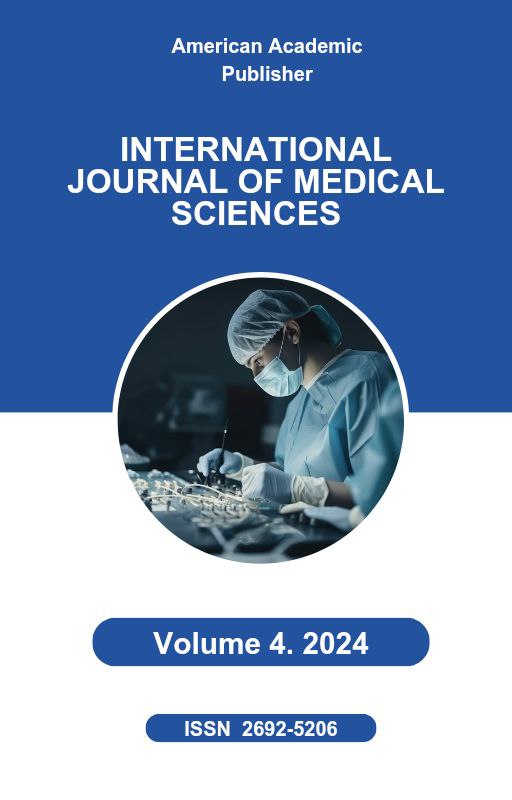 Articles
| Open Access |
https://doi.org/10.55640/
Articles
| Open Access |
https://doi.org/10.55640/
MODERN APPROACHES TO PREVENTING THE PROGRESSION OF STAGE 1 AND 2 PELVIC ORGAN PROLAPSE
Turazoda Maftuna Ulug‘bekovna , Samarkand State Medical UniversityAbstract
The scientific article on "Prevention of Progression of 1st and 2nd Degree Pelvic Organ Prolapse" is focused on studying the development of pelvic organ prolapse in women at stages 1 and 2. The article discusses the mechanisms of disease progression, its pathogenesis, and major risk factors, including pregnancy, childbirth, obesity, heredity, and the higher incidence in older women. The clinical manifestations, symptoms, and signs of the disease are also detailed. The article highlights effective conservative treatment methods for 1st and 2nd-degree prolapse, such as Kegel exercises, pessaries, physiotherapy, and weight reduction. Each of these methods is explained in terms of how they help slow down the progression of prolapse and their positive effects on the female body, supported by scientific studies and clinical experience.The article also emphasizes the importance of early diagnosis and prevention, as well as maintaining a healthy lifestyle. Early detection of 1st and 2nd-degree prolapse and the application of modern treatment approaches can significantly improve women's quality of life. Furthermore, the article recommends promoting a healthy lifestyle, regular gynecological check-ups, and preventive measures to reduce the risk of the disease.
Keywords
Pelvic organ prolapse, 1st and 2nd-degree prolapse, pathogenesis, conservative treatment, Kegel exercises, pessaries, physiotherapy, prevention, progression prevention, diagnosis, treatment, healthy lifestyle, pelvic muscles, weight control, gynecological check-ups.
References
Petros, P. E., & Ulmsten, U. (1993). An integral theory of pelvic organ prolapse and incontinence. Acta Obstetricia et Gynecologica Scandinavica, 72(7), 497-503.
Smith, F. P., & Taylor, R. N. (2001). Pelvic organ prolapse: Pathophysiology and clinical management. Obstetrics and Gynecology Clinics of North America, 28(3), 425-442.
Morley, S., & Bennett, M. (2016). Conservative management of pelvic organ prolapse. International Urogynecology Journal, 27(7), 1123-1131.
DeLancey, J. O. L. (2002). Anatomy and biomechanics of pelvic organ prolapse. Clinical Obstetrics and Gynecology, 45(3), 411-422.
Nygaard, I., & Cundiff, G. W. (2011). Pelvic organ prolapse and incontinence: Epidemiology, clinical presentations, and management. Obstetrics and Gynecology Clinics of North America, 38(3), 401-416.
Diwadkar, G. B., & Bhat, S. M. (2014). Management of pelvic organ prolapse: Current perspectives. Journal of Mid-life Health, 5(2), 63-68.
Dandolu, V., & Fagan, E. (2017). Understanding pelvic organ prolapse: Current perspectives on diagnosis and treatment. Current Opinion in Obstetrics and Gynecology, 29(5), 343-350.
Maher, C., & Feiner, B. (2011). Surgical management of pelvic organ prolapse. The Cochrane Database of Systematic Reviews, 6, CD004308.
Haylen, B. T., & DeLancey, J. O. L. (2009). International Continence Society (ICS) classification of pelvic organ prolapse. International Urogynecology Journal, 20(7), 833-842.
Swift, S. E. (2000). Pelvic organ prolapse: Anatomy and physiology. Obstetrics and Gynecology Clinics of North America, 27(4), 1-17.
Ghetti, C., & Karram, M. M. (2015). Pelvic floor disorders: Etiology and management. Obstetrics and Gynecology Clinics of North America, 42(4), 585-601.
Kegel, A. H. (1948). Progressive resistance exercise in the functional restoration of the female perineal muscles. American Journal of Obstetrics and Gynecology, 56(2), 238-248.
Rahn, D. D., & Karram, M. M. (2011). Pelvic floor disorders: Evaluation and treatment. Obstetrics and Gynecology Clinics of North America, 38(3), 445-459.
Wu, J. M., & Vaughan, C. P. (2014). Epidemiology of pelvic organ prolapse and urinary incontinence. Obstetrics and Gynecology Clinics of North America, 41(3), 431-441.
Barber, M. D., & Maher, C. (2006). Surgical management of pelvic organ prolapse. International Urogynecology Journal, 17(3), 276-282.
Article Statistics
Downloads
Copyright License

This work is licensed under a Creative Commons Attribution 4.0 International License.

